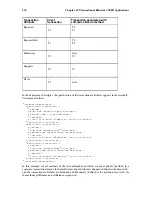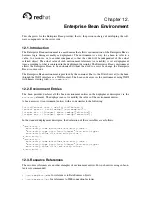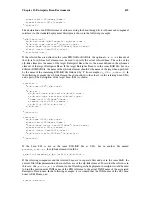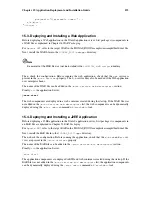
Chapter 13. Security Management
147
then obtain the distinguished name of the caller principal using the
getName()
method of the
java.security.Principal
interface.
13.3.2. Use of isCallerInRole(String roleName)
The main purpose of the
isCallerInRole(String roleName)
method is to allow the Bean pro-
grammer to code the security checks that cannot be easily defined declaratively in the deployment
descriptor using method permissions. Such a check might impose a role-based limit on a request, or
it might depend on information stored in the database.
The Enterprise Bean code uses the
isCallerInRole(String roleName)
method to test whether
the current caller has been assigned to a given security role or not. Security roles are defined by the
application assembler in the deployment descriptor and are assigned to principals by the deployer.
13.3.3. Declaration of Security Roles Referenced from the Bean’s Code
The Bean programmer must declare in the
security-role-ref
elements of the deployment de-
scriptor all the security role names used in the Enterprise Bean code. Declaring the security roles’
references in the code allows the application assembler or deployer to link the names of the security
roles used in the code to the actual security roles defined for an assembled application through the
security-role
elements.
...
enterprise-beans
...
session
ejb-name
Op
/ejb-name
ejb-class
sb.OpBean
/ejb-class
...
security-role-ref
role-name
role1
/role-name
/security-role-ref
...
/session
...
/enterprise-beans
...
The deployment descriptor in this example indicates that the Enterprise Bean
Op
makes the security
checks using
isCallerInRole("role1")
in at least one of its business methods.
13.3.4. Linking Security Role References and Security Roles
If the
security-role
elements have been defined in the deployment descriptor, all the security role
references declared in the
security-role-ref
elements must be linked to the security roles defined
in the
security-role
elements.
The following deployment descriptor example shows how to link the security role references named
role1
to the security role named
tomcat
.
...
enterprise-beans
...
session
ejb-name
Op
/ejb-name
ejb-class
sb.OpBean
/ejb-class
Summary of Contents for Application Server
Page 1: ...Red Hat Application Server JOnAS User Guide ...
Page 8: ......
Page 22: ...14 Chapter 1 Java Open Application Server JOnAS a J2EE Platform ...
Page 58: ...50 Chapter 3 JOnAS Configuration ...
Page 66: ...58 Chapter 5 JOnAS Class Loader Hierarchy ...
Page 78: ...70 Chapter 6 JOnAS Command Reference ...
Page 80: ......
Page 86: ...78 Chapter 7 Developing Session Beans ...
Page 136: ...128 Chapter 9 Developing Message Driven Beans ...
Page 142: ...134 Chapter 10 Defining the Deployment Descriptor ...
Page 148: ...140 Chapter 11 Transactional Behavior of EJB Applications ...
Page 158: ...150 Chapter 14 EJB Packaging ...
Page 162: ...154 Chapter 15 Application Deployment and Installation Guide ...
Page 164: ......
Page 176: ...168 Chapter 18 WAR Packaging ...
Page 178: ......
Page 184: ...176 Chapter 20 Defining the Client Deployment Descriptor ...
Page 186: ...178 Chapter 21 Client Packaging ...
Page 188: ......
Page 192: ...184 Chapter 23 EAR Packaging ...
Page 194: ......
Page 200: ...192 Chapter 24 JOnAS Services ...
Page 204: ...196 Chapter 25 JOnAS and the Connector Architecture ...
Page 222: ...214 Chapter 27 Ant EJB Tasks Using EJB JAR ...
Page 234: ...226 Chapter 29 Web Services with JOnAS ...
Page 236: ......
Page 260: ...252 Chapter 34 How to use Axis in JOnAS ...
Page 270: ...262 Chapter 36 Web Service Interoperability between JOnAS and BEA WebLogic ...
Page 296: ......






























